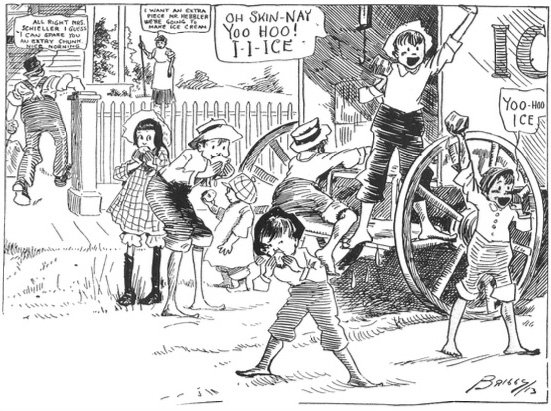The herring family includes several species as well as menhaden and shad. Herring are found along the entire east coast of the U.S., and are one of the most abundant fish in the world. These eight to fifteen inch fish return to fresh water each spring to spawn, usually April to early May. Indigenous people said that a certain bush would flower when the herring and shad returned, and that bush is known today as a Shad Bush. Actually, the fish return when the fresh water temperature becomes warmer than the salt.
Herring have played an important role in our history. They’ve been a food source and are great bait for lobster traps. They’ve been used as fertilizer, especially under corn. Up and through the 1800s, much of the catch was used for human consumption, because they kept exceptionally well when salted and smoked. They were then strung on willow or apple sticks and hung in an out-of-the-way place. Today, the roe (eggs) are eaten, either baked until dry or fried in butter. Cape Codders smoked herring almost from the start, but Nova Scotians and people from New Brunswick gained the moniker “herring chokers” by the amount of herring they ate. The Wampanoag supposedly had a secret recipe for smoking herring that people loved.
Locals have regulated herring runs from the beginning, both to ensure everyone was able to get some, as well as to prevent the damming of streams for water power which could prevent herring reaching their fresh water ponds.
Barnstable Patriot, 1852
Yarmouth has had at least seven herring runs in its past. Because Bass River runs were difficult to control as the river was owned jointly with Dennis, in 1849 both towns asked the state legislature to appoint a joint herring committee to control weirs and fishing. Bass River is the beginning of two Yarmouth runs. One went to Laban’s Pond on the Bass River Golf Course. Pesticides and fertilizers ended this run. Another run went from Follins Pond to Mill Pond up Hamblin Brook to Miss Thatcher’s Pond near Seminole Drive. This run was quite profitable, selling for $710 to Nathan Grush in 1880. In 1883, it produced the second most herring in the state : 280,797. However, by 1914, the highest price paid for any herring grant on Bass River was just $31.
A third run went past West Yarmouth’s Baxter Mill up into the Mill Pond (another one) and on to Little Sandy Pond, now town recreation land. A fourth went up Mill Creek, then under Route 28 near where the 1750 house used to stand, and on through the cranberry bogs and on to Jabez Ned’s Pond just south of Buck Island Road.
Baxter Mill
A fifth went up Parker’s River to Swan Pond and then up Clear Brook under what is now Forest Road to Long Pond. In the long term, this was probably the most profitable in the town. The state legislature enabled it in 1843 when it allowed the owners to open an outlet from Long Pond to Swan Pond. This was a half mile of digging! It is still an active run.
The sixth and seventh runs both went up Chase Garden Creek on the northside and into White’s Brook. One then went into Matthews Pond on Bass River Rod and Gun Club property, while the other continued under Route 6A to a little pond behind the town pumping station building on Union Street.
Three runs in Yarmouth are still active. The biggest is the Clear Brook Run. Under the direction of the Yarmouth Department of Natural Resources, the brook was dug out in 2009 where it was too shallow and a culvert was removed at the end of Clear Brook Road. A bridge was built over the stream. Americorps helped improve that run in 2009. In 2011, the Cape Cod Salties fishing organization helped clean the whole brook and did a wonderful job. Herring can be seen from the bridge at the end of Clear Brook Road, and from the walkway on Forest Road. Before the improvements, some herring made it through to Long Pond, but now far more are making their spawning journey.
The fish ladder beside the Baxter Mill on Route 28 is still active. Herring used to swim through Mill Pond and up to Little Sandy Pond, but that stream is now blocked. The herring spawn in Mill Pond and return to the ocean down Mill River.
In the 1960s, the Bass River Rod and Gun Club built a fish ladder into Matthews Pond to allow the herring to spawn there. The state stocked it for several years until the herring returned on their own. The club, with the help of groups such as the Cape Cod Salties, maintains the run.
So, when the Shad Bush flowers this spring, look for herring right here in Yarmouth. Remember the state-wide ban on taking herring, so only look, though local indigenous people do retain the right to harvest. The osprey and seagulls know when they arrive - they are part of the welcoming committee!
Shad bush
Excerpted from an article by Duncan Oliver














































































